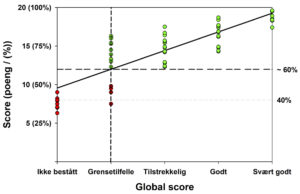In the new curriculum for the medical students at our faculty, Medicine 2015, it has been decided that what is referred to as OSCE examinations (O = objective; S = structured; C = clinical; E = examination) should be introduced and included. One of the main arguments for this is to secure a fairer evaluation and grading compared to the current clinical examinations. There are arguments both pro and con. However, we all must relate to this decision and make sure that these examinations are performed in a proper manner. The first ordinary OSCE examination will be on June 20th, 2018 for 160 medical students. The OSCE exam is a station-based exam (“circle exercise”), and all students are examined at all stations.
As announced since April/May, the fourth and last pilot-OSCE examination will be on Wednesday November 8th (in about one month). The pilot medical students to be examined this time are from Class 14-B. They have been medical students for about 3½ years by now. Altogether, 39 examiners are needed to run three parallel circles with 13 different active stations. Examiners from Departments of Biomedicine, Clinical Medcine, Clinical Science and Global Public Health and Primary Care will be more or less involved as examiners. There will be electronic and online assessment with laptop at each station.
This is an example of the checklist for the examination in one of the stations used in the pilot examination in May this year:
This example is related to the teaching in neurophysiology at the Departments of Biomedicine. The “objectivity” is secured by evaluating all candidates and issuing points on each single question/element in the checklist. A global score (totalvurdering) is the examiner’s overall and general judgement and impression of the candidate’s performance, independent of points actually obtained.
By a Single borderline score regression analysis, the global evaluation (Not passed, Borderline, Sufficient, Good, Excellent) is plotted on the x-axis vs. the points scored for every student (in this example 68) on the y-axis. If a score of > 40% of the points is preset as the limit for passing this station, 6 students have failed. In this example, the regression analysis will adjust the limit to ~ 60%, and 12 students will fail. The borderline regression analysis corrects for an easy station where many students obtain high scores and a more difficult task/station where many students obtain a low score.
This pilot OSCE examination will commence at. 08:00 a.m. on November 8th, and is finished by lunchtime.
Ketil Grong


